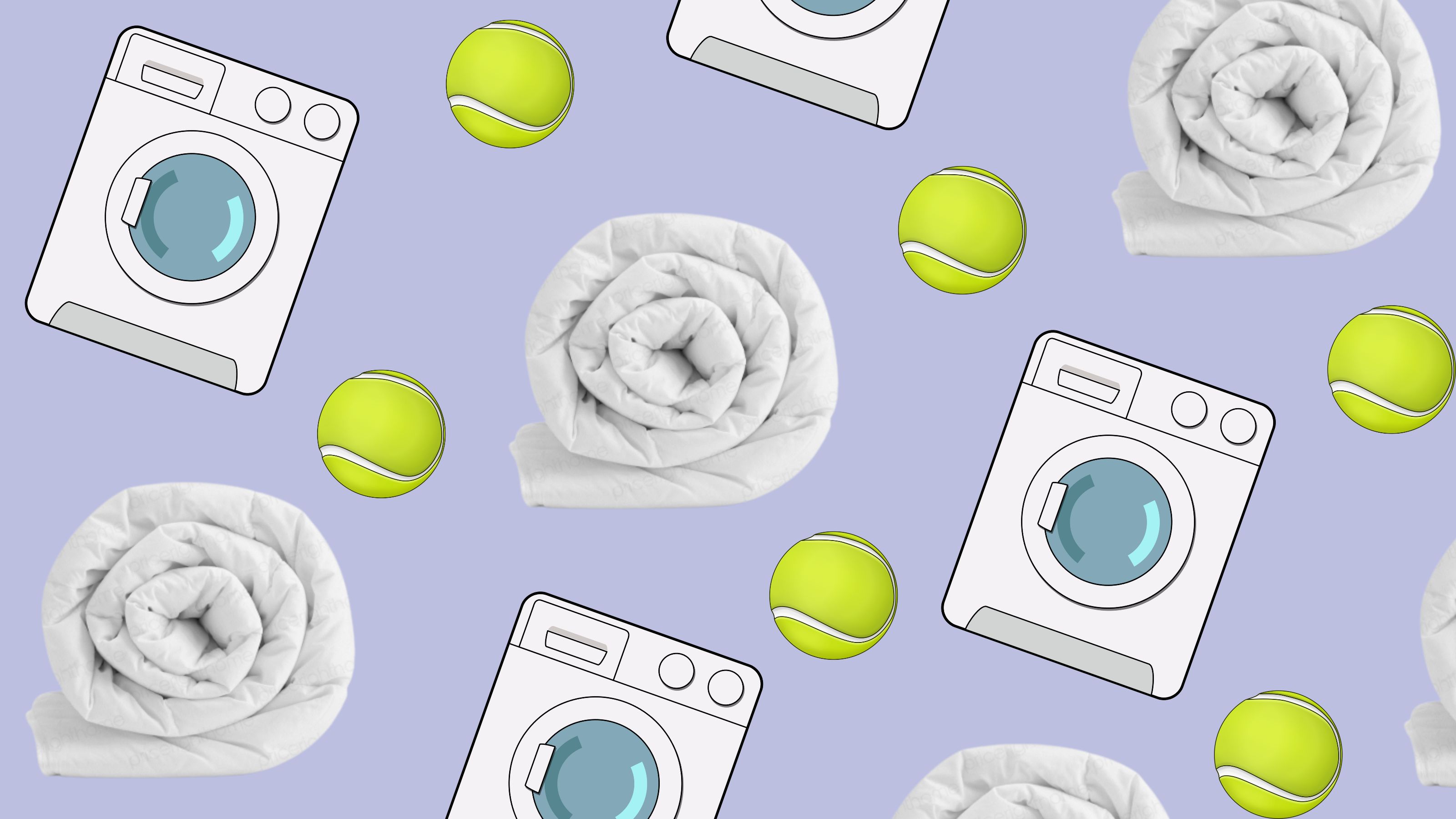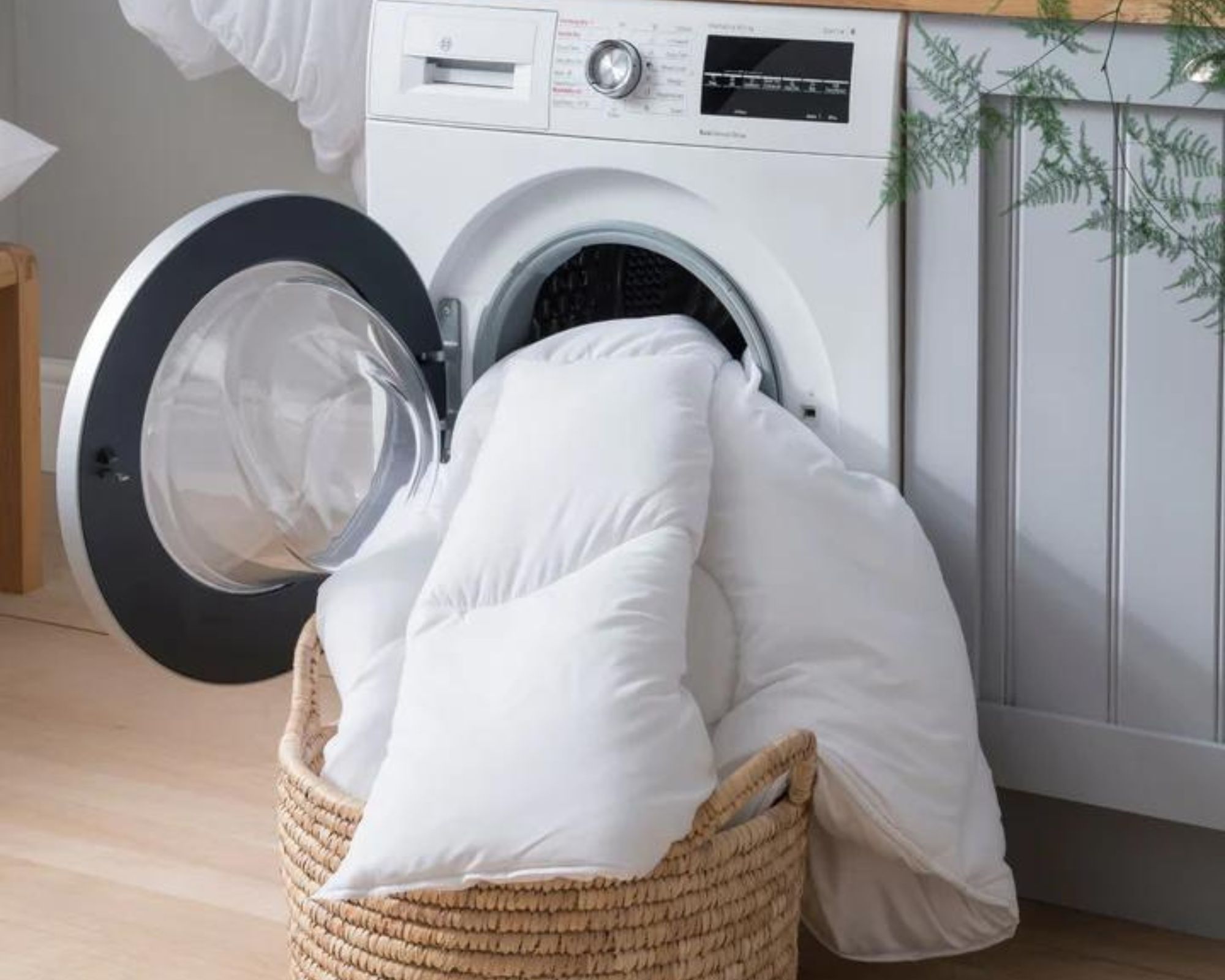

If you've ever had to lug your sopping wet comforter out of the washer and hang it on the line, you'll know how heavy they are. And how long they take to dry. Honestly, I did this in the summer and waited a good three days for my duvet to properly dry off. Big mistake. I was left without any covers for a few nights (because I had an all-season option) and a limp duvet that had lost its fluff.
Whether you've got a luxe down duvet you've invested your savings in or a lightweight synthetic comforter you picked up on sale, knowing how to care for one is key. Yes, you can dry your duvet in the dryer, but putting it in a drum that's too small or on too high of a heat setting can cause material damage. Leaving it out in the sun isn't the best either.
So you don't make the same error I did, I spoke to some experts for their tips on how to dry a comforter without it bunching, lumping, or shrinking. Follow these simple steps to make the drying process a whole lot quicker and easier. The best tip includes a tumble dryer and tennis balls. If only I knew earlier...
How to dry a comforter

Good to know
Drying a comforter isn't a quick task you can do when you get a spare min, it will take a little time. Unlike washing your sheets, which requires a quick read of the care label and setting the washer to the correct settings, drying your duvet takes a little more human power. But you'll be pleased to know that you don't have to clean your duvet as often as you have to wash its cover. Washing and drying your duvet about once a month is recommended.
Note: If you're wanting to dry your duvet in the dryer, make sure the drum is big enough. Comforters can be large and bulky and will need enough room to effectively spin and rinse in your machine. If your at-home machine is small, try taking it to the local laundromat. I'll also be using the terms duvet and comforter interchangeably throughout this step-by-step guide.
Here's what you'll need
- A dryer with a large capacity drum for bigger duvets and comforters
- Dryer balls, like these natural wool dryer balls from Amazon (or some tennis balls if you have them)
- A laundry line/rack
1. Check the type of comforter
Before you chuck your comforter into the dryer, make sure to check the type you have. The two most common types of duvets are natural (e.g. feather-filled or made of down) or synthetic, which is typically made of polyester or fiberfill. No matter which comforter you have, you can dry all material types by machine. But be sure to read the laundry symbols on the care label as temperature and spin speed will differ by material — with some high tog options being dry clean only.
2. Put the comforter in the dryer
A simple step, yes, but there are some crucial details. When putting your comforter in the dryer, spread out the material as much as possible. As Parima Ijaz, founder of Pure Parima, states "A big concern people have when it comes to cleaning their comforter is losing its fluff and plushness — the whole reason you use a comforter in the first place!" Adding a few dryer balls or tennis balls too will balance the weight and "help to keep the fluff evenly distributed to avoid ending up with a flat comforter that no longer carries volume."
Get small space home decor ideas, celeb inspiration, DIY tips and more, straight to your inbox!
3. Select a low temperature setting
Jonathon Reckles, vice president of marketing at CD One Price Cleaners, and several other experts suggest using a "lower heat setting." Even if your dryer does have a large drum, a big comforter may get stuck. If on a higher temperature setting, the duvet could get too hot, and potentially burn. Reckles notes that using a low heat setting "may take a couple of cycles, but that's okay." You can always check the label if you're unsure as they'll usually have a recommended drying temperature.
4. Hit pause and shake
This is where drying your comforter can get a little tedious. But trust me: follow this step especially and you'll have a duvet that's clean, dry, and cozy AF. Either set a timer on your phone or the machine itself for 20 to 30 minutes and take out your comforter to give it a physical fluff. Shaking out your comforter by hand will "ensure there's equal distribution of filling for a quick, and balanced dry," says Reckles.
5. Continue drying on a clothes line
Don't stress if your comforter is taking more than a couple of cycles to get dry. Especially if you have a weighty feather-filled or down comforter, you can expect the drying time to take a while. Once your duvet is almost dry — too damp to put on the bed, but dry enough not to warrant another cycle — then finish the job using a clothesline or laundry drying rack.
FAQs
How to dry a comforter without a dryer
Not everyone has a dryer. In fact, most rentals tend to come with a washer only (annoying, IKR), but that doesn't mean you can't dry your comforter. In fact, drying your washing naturally is less damaging to your duvet and better on your energy bills and the environment.
To dry your comforter without a dryer, set up a clothesline or drying rack in a warm dry place, inside or out. Hot weather and wind will help your duvet dry quicker, and direct sunlight will brighten white fabric and fade any stains.

Louise is the Ecommerce Editor at Real Homes, specialising in sleep content so you can wind-down well. With prior PR experience working for a luxury bedding brand, Louise knows the importance of getting a great night’s sleep. Joining the other side of the desk as a full-time journo, Louise brings her bedding expertise to writing sleep buying guides, reviews, and news for Real Homes. Aside from helping readers get essential shut eye, Louise also writes shopping content for homeware items that’ll add a decorative edge to your space. With an eye for design that won’t snooze on style, but a budget that won’t quite stretch, Louise loves nothing more than a modern designer dupe. From coloured glassware to contemporary storage, anything to upgrade the bare space of her rented East London flat.